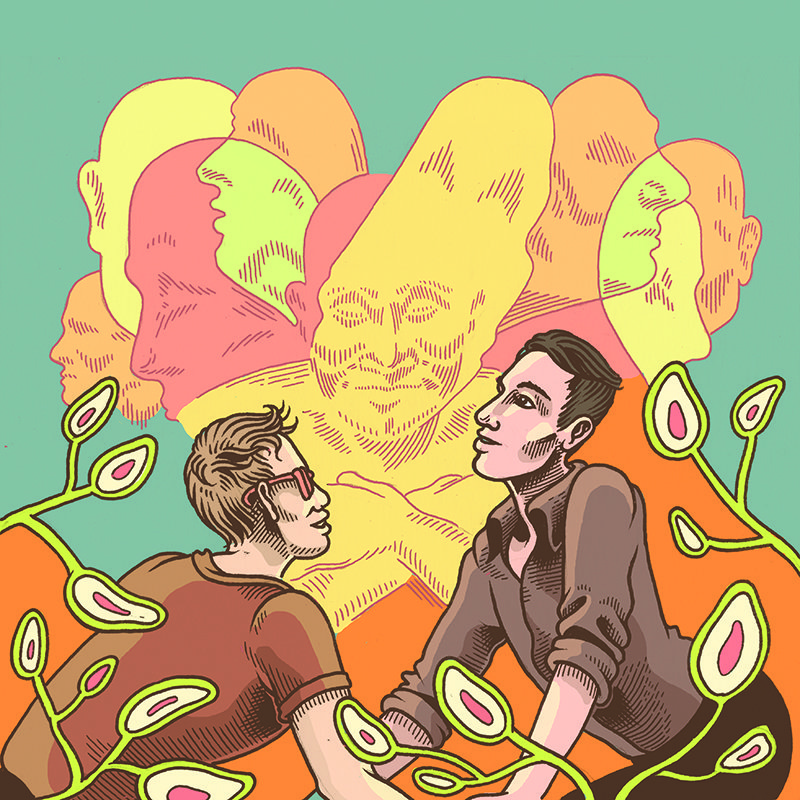When I was in my fourth year at York University, I had the opportunity to visit Victoria, BC, for the annual Canadian University Queer Services Conference. I was surprised when many of the organizers and speakers started sessions by acknowledging their use of the traditional lands of the Songhees and Esquimalt First Nations. Another surprise came when I ended up going home with Trevor, a cute guy from the Prairies doing indigenous studies at Camosun College. My first fling! I barely gave it a second thought when he described his native background – I was a little more caught up in spending the weekend with him and didn’t stay a single night in my hotel room. In hindsight, that weekend was my introduction to the convergence of the aboriginal and queer/trans communities.
Speaking about the historical tradition of two-spirit people is slightly misleading. While many aboriginal communities and languages have long had different words to describe similar ideas and identities, the term two-spirit originated in 1990 at the third intertribal Native American/First Nations gay and lesbian conference in Winnipeg. “Two-spirit” is a direct translation from the Ojibwe niizh manidoowag. It’s explained by The Legacy Project, a Chicago-based queer history project with an international scope: “Constituting a multiplicity of masculine/feminine constructs, these profoundly socially aware individuals – known today as ‘two-spirit’ – share a mixed-gender consciousness that is said to result from being born with both a male and female spirit.” Like “queer” and “trans,” the contemporary term is meant to represent a spectrum of self-identification that reflects traditional First Nations gender diversity. However, not every aboriginal community uses “two-spirit”; nor does every lesbian, gay, bisexual or trans aboriginal person identify as two-spirit.
Two-spirit people existed long before the term was created to describe them: in North America there were approximately 400 distinct indigenous nations, and of those, 155 have documented multiple gender traditions. In many communities these people occupied unique positions, sometimes acting as liaisons between the sexes, or as shamans, medicine people, child caregivers, social workers or mediators. This mediation sometimes extended between the spiritual and physical world, and two-spirit people were often consulted when spiritual concerns arose.
Different explorers on separate occasions observed the child of an Ojibwe chief, Ozaawindib, who was “a curious compound of man and woman. He is a man both as to his members and his courage, but pretends to be womanish, and dresses as such. His walk and mode of sitting, his manners, occupations, and language are those of a woman.”
A French military man turned travel writer named Baron de Lahontan wrote of aboriginal women who refused to take husbands. “That sort of Women are call’d Ickoue ne Kioussa, ie Hunting Women: for they commonly accompany the Huntsmen in their Diversions. To justify their Conduct, they alledge [sic] that they find themselves too indifferent a temper to brook the Conjugal yoak [sic], to be too careless for the bringing up of children, and too impatient to bear the passing of the whole Winter in the Villages.”
Despite these mild-mannered descriptions, most settlers wanted two-spirit traditions eradicated, and they almost had their wish. By the end of the 19th century, observations of two-spirit people by the entrenched settler population had disappeared entirely. The malevolent 1876 Indian Act, which sought to further suppress Canadian aboriginal people, didn’t even need to mention the almost forgotten ceremonies surrounding two-spirit people.
Luckily, bigoted settlers failed to extinguish the traditions entirely, and, especially since the late 20th century, there has been a renaissance of two-spirit traditions. Aboriginal people, especially those who are queer, trans and two-spirit, face an incredible amount of virulent, institutionalized discrimination, but their strength is demonstrated through their rich history and resilient spirits. Our two-spirit brothers, sisters and lovers occupy a complex, unique position among aboriginal communities, and the broader queer community has much to learn from them.


 Why you can trust Xtra
Why you can trust Xtra


